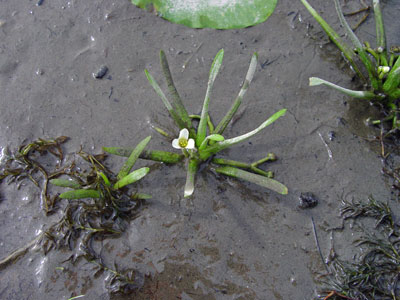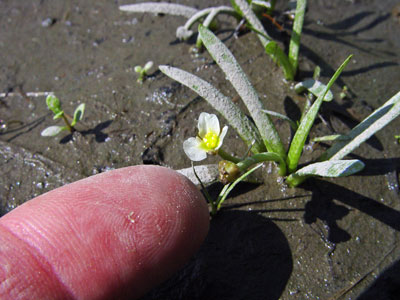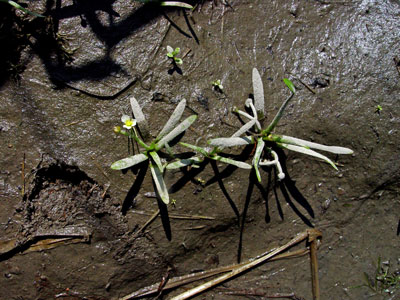DACF Home → Bureaus & Programs → Maine Natural Areas Program → Communities, Plants, and Animals → Rare Plants → Sagittaria montevidensis ssp. spongiosa

Sagittaria montevidensis Cham. & Schlecht. ssp. spongiosa (Engelm.) Bogin
Spongy-leaved Arrowhead
- State Rank: S3
- Global Rank: G5T4
- State Status: Special Concern
Habitat: Tidewater marshes and streams. [Tidal wetland (non-forested, wetland)]
Range: On estuarine rivers, New Brunswick to Virginia.
Aids to Identification: Arrowheads are aquatic plants with 3-petalled white flowers and numerous stamens and carpels. The septate nodulose roots are distinctive. Young plants of many arrowheads often grow as clumps of narrow leaves which differentiate to various arrow shapes as they mature and emerge above water. This species, however, typically retains its thick, spongy, bladeless phyllodia (modified petioles), only occasionally showing narrowly sagittate leaves. Flowers, often single, on drooping thick pedicels, with sepals ascending in fruit.

Ecological characteristics: Being somewhat more tolerant of mild salinity than many other estuarine species, Sagittaria calycina usually grows in the mid to lower intertidal zone in our area. It can be found under a sparse canopy of Spartina alterniflora, Scirpus acutus, or Zizania aquatica or on open mud. Its occurrence is patchy varying with microtopography, proximity of freshwater springs, and the salinity of the tidal water. The further upstream in the estuary, the lower in the intertidal zone it will be found.
Phenology: Flowers and fruits July - October.
Family: Alismataceae
Synonyms: Lophotocarpus spathulatus J.G. Sm.; Lophotocarpus spongiosus (Engelm.) J.G. Sm.; Sagittaria calycina Engelm. var. spongiosa Engelm.; Sagittaria montevidensis Cham. & Schlecht. var. spongiosa (Engelm.) Boivin; Sagittaria spatulata (J. G. Sm.) Buch.

Known Distribution in Maine: This rare plant has been documented from a total of 22 town(s) in the following county(ies): Kennebec, Knox, Lincoln, Penobscot, Sagadahoc, Waldo, York.
Reason(s) for rarity: Habitat naturally scarce and being altered/depleted by human activities.
Conservation considerations: Prevent degradation of estuary habitat from adjacent land uses.